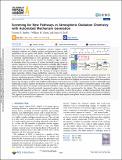Screening for New Pathways in Atmospheric Oxidation Chemistry with Automated Mechanism Generation
Author(s)
Barber, Victoria P; Green, William H; Kroll, Jesse H
DownloadPublished version (3.326Mb)
Publisher with Creative Commons License
Publisher with Creative Commons License
Creative Commons Attribution
Terms of use
Metadata
Show full item recordAbstract
In the Earth's atmosphere, reactive organic carbon undergoes oxidation via a highly complex, multigeneration process, with implications for air quality and climate. Decades of experimental and theoretical studies, primarily on the reactions of hydrocarbons, have led to a canonical understanding of how gas-phase oxidation of organic compounds takes place. Recent research has brought to light a number of examples where the presence of certain functional groups opens up reaction pathways for key radical intermediates, including alkyl radicals, alkoxy radicals, and peroxy radicals, that are substantially different from traditional oxidation mechanisms. These discoveries highlight the need for methods that systematically explore the chemistry of complex, functionalized molecules without being prohibitively expensive. In this work, automated reaction network generation is used as a screening tool for new pathways in atmospheric oxidation chemistry. The reaction mechanism generator (RMG) is used to generate reaction networks for the OH-initiated oxidation of 200 mono- and bifunctionally substituted n-pentanes. The resulting networks are then filtered to highlight the reactions of key radical intermediates that are fast enough to compete with traditional atmospheric removal processes as well as "uncanonical" processes which differ from traditionally accepted oxidation mechanisms. Several recently reported, uncanonical atmospheric mechanisms appear in the RMG dataset. These "proof of concept" results provide confidence in this approach as a tool in the search for overlooked atmospheric oxidation chemistry. Several previously unreported reaction types are also encountered in the dataset. The most potentially atmospherically important of these is a radical-carbonyl ring-closure reaction that produces a highly functionalized cyclic alkoxy radical. This pathway is proposed as a promising target for further study via experiments and more detailed theoretical calculations. The approach presented herein represents a new way to efficiently explore atmospheric chemical space and unearth overlooked reaction steps in atmospheric oxidation.
Date issued
2021Department
Massachusetts Institute of Technology. Department of Civil and Environmental Engineering; Massachusetts Institute of Technology. Department of Chemical EngineeringJournal
Journal of Physical Chemistry A
Publisher
American Chemical Society (ACS)
Citation
Barber, Victoria P, Green, William H and Kroll, Jesse H. 2021. "Screening for New Pathways in Atmospheric Oxidation Chemistry with Automated Mechanism Generation." Journal of Physical Chemistry A, 125 (31).
Version: Final published version